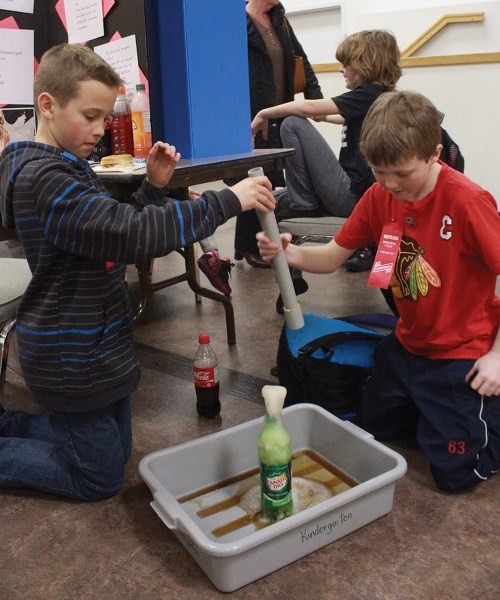The 48th annual Westlock Local Science Fair attracted 128 young scientists from eight schools spanning Pembina Hills Public Schools and St. Mary School.
Experiments on display at the Westlock and District Community Hall March 1 ranged from dropping Mentos candies into pop to create an explosion, to an in-depth study of tooth decay, an examination on the power of suggestion over tastebuds and a prototype clean-energy power generator that converts kinetic energy into electricity using magnetism. One student even presented an elaborate study on plasma.
“The fair has gone through a few changes in the last few years,” said Dunstable School principal Tammy Tkachuk, one of the organizers of the fair. “We opened it up two years ago to add innovations and studies, not just experiments.”
Students in Grades 4 and up who won are now able to attend the Edmonton Regional Science Fair at NAIT in April.
Attending the NAIT fair is optional for students although Tkachuk estimated that Westlock typically sends 10-15 projects to the Edmonton fair.
“Over the years, we’ve had students who have gone on to the Edmonton fair and have placed first,” said Tkachuk.
“A few years ago we had a couple students who have gone on to the national science fair as well. It’s a really good starting place for our students to have this opportunity.
“Those students who go on to the national fair, they are coached and mentored. It leads naturally to further studies and opens doors for them.”
Participation in the science fair is optional for students as all the experiments, research and preparation are done on kids’ own time.
“It’s entirely up to them, we start talking about the fair usually right before Christmas so they have a month or two to put into it, but there are some students who take a lot longer and put a lot more into their projects.
“Especially the older students, some of them are working on this months and months in advance.
“But it’s their own time. It’s something they do on their own at home.”
While students are ultimately responsible for their own projects, Tkachuk noted that teachers and staff are happy to put in the time to mentor them on their chosen inquiry.
“Most of our schools have a school science fair before we have the Westlock science fair,” she said. “Often what happens is that kids are working on their projects, get feedback when they present them at school and get suggestions on things they can improve before they get to the big fair.”
Tkachuk added that participating in the fair gives kids a chance to wrap their heads around the Scientific Method and helps them build contacts for their future endeavours.
“We often get repeat-scientists. In Grades 1, 2 or 3 they start with a little project,” she said. “Then they get bitten by the science bug. We see a lot of the same names year after year. It’s about building that passion for science.”



